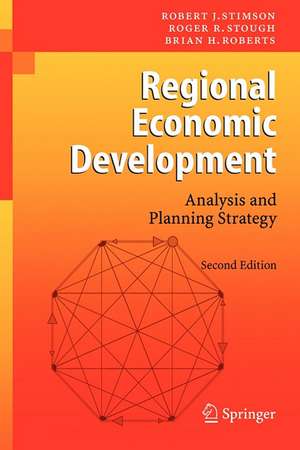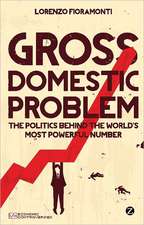Regional Economic Development: Analysis and Planning Strategy
Autor Robert J. Stimson, Roger R. Stough, Brian H. Robertsen Limba Engleză Paperback – 15 sep 2006
Preț: 650.69 lei
Preț vechi: 765.51 lei
-15% Nou
Puncte Express: 976
Preț estimativ în valută:
124.54€ • 129.53$ • 104.37£
124.54€ • 129.53$ • 104.37£
Carte tipărită la comandă
Livrare economică 13-27 martie
Preluare comenzi: 021 569.72.76
Specificații
ISBN-13: 9783540348269
ISBN-10: 3540348263
Pagini: 468
Ilustrații: XIV, 452 p. 101 illus.
Dimensiuni: 155 x 235 x 29 mm
Greutate: 0.7 kg
Ediția:2nd ed. 2006
Editura: Springer Berlin, Heidelberg
Colecția Springer
Locul publicării:Berlin, Heidelberg, Germany
ISBN-10: 3540348263
Pagini: 468
Ilustrații: XIV, 452 p. 101 illus.
Dimensiuni: 155 x 235 x 29 mm
Greutate: 0.7 kg
Ediția:2nd ed. 2006
Editura: Springer Berlin, Heidelberg
Colecția Springer
Locul publicării:Berlin, Heidelberg, Germany
Public țintă
GraduateCuprins
Perspectives on Regional Economic Development.- The Regional Economic Development Movement: The Evolution of Strategy from Early to Contemporary Approaches.- Traditional Tools for Measuring and Evaluating Regional Economic Performance I: Economic Base and Shift-Share Analysis.- Traditional Tools for Measuring and Evaluating Regional Economic Performance II: Input-Output Analysis.- Path Setting: An Approach to Regional Economic Development Futures.- Industry Clusters and Industry Cluster Analysis.- Multi-Sector Analysis: Approaches to Assessing Regional Competitiveness and Risk.- Capacity Building, Institutions and Leadership for Regional Economic Development.- Decision Support Tools to Inform Regional Economic Development Analysis and Strategy.- Emerging Issues for Regional Economic Development.
Recenzii
From the reviews of the second edition:“The second edition of Stimson, Stough and Roberts Regional economic development is aimed primarily at students, researchers, or public policy-makers who are actively involved in the nuts and bolts of local or regional economic development. … In terms of its objectives the book is an invaluable asset, providing as it does an ideal volume for both teaching and strategy development … . I myself am currently using this book for teaching students … . I recommend others to do the same.” (Philip McCann, Papers in Regional Science, Vol. 88 (3), August, 2009)
Textul de pe ultima copertă
The second edition of this book is completely reedited making the book even more valuable for graduate students, reflecting recent advances and adding insightful new material.
The book is about the analysis of regional economic performance and change, and how analysis integrates with strategies for local and regional economic development policy and planning. First, the book provides the reader with an overview of key theoretical and conceptual contexts within which the economic development process takes place. However, the deliberate emphasis is to provide the reader with an account of quantitative and qualitative approaches to regional economic analysis and of old and new strategic frameworks for formulating regional economic development planning.
The second edition brings to the present its original thesis about the need for regions to be fast and flexible, but also to be proactive in order to be prepared to experience increasingly greater shocks while having less time to adjust their economic development to achieve sustainability. This is underscored by events that have occurred since 2001: 9/11 terrorist attacks, continuing rapid advances in technology, the rise China and India, the Tsunami, and all the known on-going and unforeseen risks and challenges that confront nations around the globe and the regions and localities within them. The book presents strategies and the traditional and expanded methods used to create and implement them.
The book is about the analysis of regional economic performance and change, and how analysis integrates with strategies for local and regional economic development policy and planning. First, the book provides the reader with an overview of key theoretical and conceptual contexts within which the economic development process takes place. However, the deliberate emphasis is to provide the reader with an account of quantitative and qualitative approaches to regional economic analysis and of old and new strategic frameworks for formulating regional economic development planning.
The second edition brings to the present its original thesis about the need for regions to be fast and flexible, but also to be proactive in order to be prepared to experience increasingly greater shocks while having less time to adjust their economic development to achieve sustainability. This is underscored by events that have occurred since 2001: 9/11 terrorist attacks, continuing rapid advances in technology, the rise China and India, the Tsunami, and all the known on-going and unforeseen risks and challenges that confront nations around the globe and the regions and localities within them. The book presents strategies and the traditional and expanded methods used to create and implement them.
Caracteristici
Second edition is completely reedited, reflecting recent advances in research and focusing on students as the main target group Important methods of analysis in regional economics based on new models and their applications Illustrations of methods for building and implementing regional economic development strategies New features: Regional risk assessment, endogenous regional growth, leadership and institutions, cluster identification New material in chapter 1,6,7,8,9, and 10













